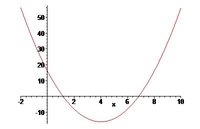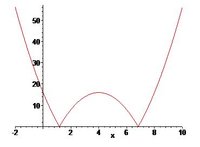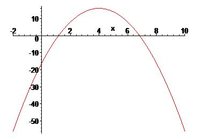Hi Erin. The answer is yes, if you're talking about a parabola that opens upward and the bottom part of that parabola lies below the x-axis. In such a graph, nothing has been reflected across the x-axis.
Here's an example of what I'm thinking.
y = 2x^2 - 16x - 16
View attachment 23103
Part of the parabola lies below the x-axis, two points of the parabola lie directly on top of the x-axis, and the remaining part of the parabola lies entirely above the x-axis.
If we plot the absolute value of 2x^2-16x-16, instead, then the part below the x-axis (above) will be reflected across the x-axis, in the new graph.
y = | 2x^2 - 16x - 16 |
View attachment 23104
If we multiply the polynomial by -1, then the entire parabola is reflected across the x-axis. (Every y-value that was positive in the first graph above becomes negative, and every y-value that was negative becomes positive. This effectively reflects every point (except for the x-intercepts) across the x-axis, flipping the entire parabola.
y =
-(2x^2 - 16x - 16)
View attachment 23105
I hope these images help you understand what reflections are. Please feel free to add any questions you may have.
?



